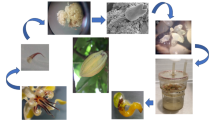Summary
Zygotes of rice (Oryza sativa L. cv Taichung 65) were treated with 1.0 mM solution of the chemical mutagen N-methyl-N-nitrosourea. Out of 1420 M2 lines, 28 single-locus recessive mutants on embryogenesis were identified. Among them, we analyzed 11 mutants in the present study, which differentiated the shoot (plumule) and/or root (radicle) with abnormality. Of the 11 mutants, two showed no shoot differentiation with normal root. On the other hand, we could not detect any mutant which exhibited a normal shoot without a root. This suggests that shoot and root are genetically controlled by different loci and that the alleles associated with shoot formation mutate more frequently than do those of the root. Five mutants showed aberrant morphology of shoot when both the shoot and root developed. One of them, odm 5 (organ differententiation mutant 5) was germinable, but produced many fine and twisted leaves. This mutant was, however, lethal at the early post-germination stage under the usual cultural conditions. In another mutant (odm 4), shoot differentiation seemed to be initiated at an arbitrary position, resulting in a very abnormal morphology of the shoot when the position fronted the endosperm. The other two mutants showed abnormal morphology of both the shoot and root. One (odm 11) of the remaining two mutants showed a wide variation of abnormalities including no organ differentiation, either shoot or root differentiation and the development of both shoot and root with abnormalities. The last one (odm 16) was unique. It had an embryo with normal shoot and root but the embryo size was only one-third to one-half of normal embryos in length. Of course, the shoot and root are also small but viable. Therefore, odm 16 is considered to be a mutant in the size regulation of the embryo. Although an allelism test has not yet been done, most of these mutants are probably non-allelic, as the phenotypic abnormality differs largely with each one. In rice, the shoot and root highly differentiate in contrast to dicotyledonous embryo. Accordingly, these developmental mutants are very useful materials for investigating the regulatory mechanism of gene expression in organ differentiation.
Similar content being viewed by others
References
Lewis EB (1978) A gene complex controlling segmentation in Drosophila. Nature 276:565–570
McGinnis W, Garber RL, Wirz J, Kuroiwa A, Gehring WJ (1984a) A homologous protein-coding sequence in Drosophila homoeotic genes and its conservation in other metazoans. Cell 37:403–408
McGinnis W, Levine MS, Hafen E, Kuroiwa A, Gehring WJ (1984b) A conserved DNA sequence in homoeotic genes of the Drosophila antennapedia and bithorax complexes. Nature 308:428–433
Meinke DW (1985) Embryo-lethal mutants of Arabidopsis thaliana: analysis of mutants with a wide range of lethal phases. Theor Appl Genet 69:543–552
Meinke DW, Sussex IM (1979) Isolation and characterization of six embryo-lethal mutants of Arabidopsis thaliana. Dev Biol 72:62–72
Meinke DW, Franzmann L, Baus A, Patton D, Weldon R, Heath JD, Monnot C (1985) Embryo-lethal mutants of Arabidopsis thaliana. In: Freeling M (ed) Plant genetics, UCLA Symp Mol Cell Biol, vol 35. Alan Liss, New York, pp 129–146
Neuffer MG, Sheridan WF (1980) Defective kernel mutants of maize. I. Genetic and lethality studies. Genetics 95:929–944
Raghavan V (1986) Embryogenesis in angiosperms. Cambridge University Press, London
Satoh H, Omura T (1986) Mutagenesis in rice by treating fertilized egg cells with nitroso compounds. In: Rice genetics. Proceedings of the International Rice Genetics Symposium. International Rice Research Institute, Manila, pp 707–717
Scott MP, Weiner AJ (1984) Structural relationships among genes that control development: sequence homology between the Antennapedia, Ultrabithorax and fushi tarazu loci of Drosophila. Proc Natl Acad Sci USA 81:4115–4119
Sheridan WF, Clark JK (1987) Maize embryogeny: a promising experimental system. Trend Genet 3:3–6
Author information
Authors and Affiliations
Additional information
Communicated by P.L. Pfahler
Rights and permissions
About this article
Cite this article
Nagato, Y., Kitano, H., Kamijima, O. et al. Developmental mutants showing abnormal organ differentiation in rice embryos. Theoret. Appl. Genetics 78, 11–15 (1989). https://doi.org/10.1007/BF00299746
Received:
Accepted:
Issue Date:
DOI: https://doi.org/10.1007/BF00299746




